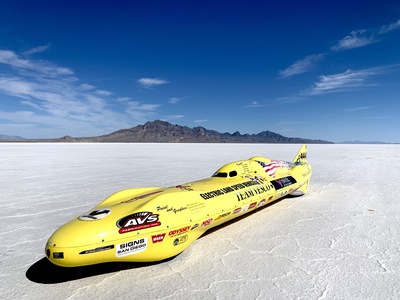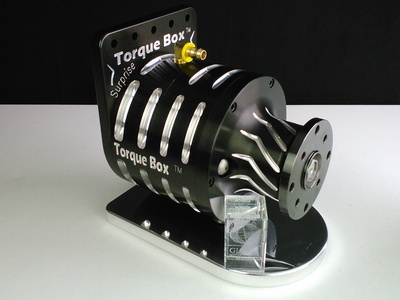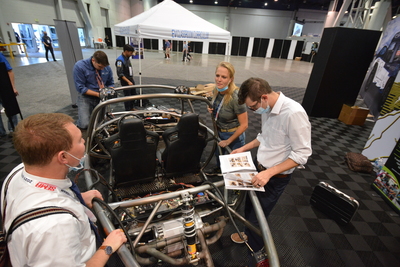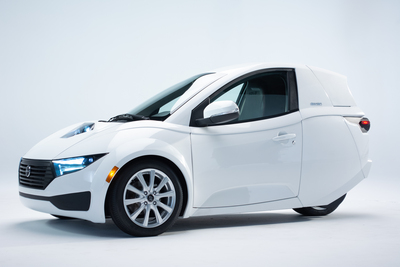BUSINESS
Meeting Electrification Head-On
How Leading-Edge Innovators Are Sparking New Opportunities in the EV Market Space
By Mike Imlay

The Team Vesco 444 reVolt Systems “Little Giant” EV streamliner recently conquered the National Electric E3 record at the Bonneville Salt Flats, setting a 353-mph average. EV proponents see electrified performance as the aftermarket’s next frontier.
The automotive industry’s trend toward vehicle electrification continues to make headlines, with OEMs announcing bold new initiatives at a quickening pace. Of the top 20 global automakers, which together represented around 90% of new-car registrations worldwide in 2020, 18 are already at work widening their portfolios of alternative-power platforms and scaling up production of electric vehicles (EVs). This trend is obviously a hot-button topic for the aftermarket, with many asking how it will ultimately impact the industry.
But the specialty-equipment industry has never been one to shy away from a challenge. In fact, numerous innovators are already seizing opportunities in the EV space, and their entrepreneurial spirit was on full display at the 2021 SEMA Show in Las Vegas. Throughout Show week, exhibitors proudly unveiled EVs, electric conversions and related new products to Show attendees, and an expanded SEMA Electrified section showcased key companies making their names known in the market. In addition, the Show was the venue for special OEM announcements relating to vehicle electrification and alternative-power platforms, notably from Ford Motor Company and Chevrolet.
“We’ve been excited to see the growth and increased interest in the SEMA Electrified section of the SEMA Show since the feature first debuted several years ago,” said Tom Gattuso, SEMA vice president of events. “This year, SEMA Electrified included a number of electric-vehicle projects showcasing emerging technologies and the amazing strides the aftermarket is making in building, modifying, converting and accessorizing alternative-power platforms. Moreover, the SEMA Electrified feature at the Show demonstrated the association’s commitment to helping the industry understand and leverage cutting-edge technologies and stay ahead of trends.”
Throughout the Show, electrified builds and electrification projects garnered significant media attention (see “Required Reading,” p. 18). But most important of all, the palpable interest of industry attendees demonstrated that the trend is no longer considered a flash in the pan. Builders and product developers alike are seeing a profitable future in electrification and are ready to embrace the enhancements to vehicle design and performance that it can offer.
Although alternative powertrains currently represent just 1% of light vehicles in operation on American roads, those numbers are rising each year. In fact, SEMA Market Research has identified several areas of opportunity for the aftermarket, including the development of parts and products to aid in the conversion of older internal-combustion vehicles; building or modifying new project, racing and purpose-built vehicles; and expertly accessorizing new OEM electric offerings.
Torque Trends, based in Arizona, is an example of a new breed of manufacturers that are supplying products to aid in vehicle conversions—in this case, EV reduction gearboxes.

Torque Trends, a supplier of gear-reduction boxes for builders and installers making EV conversions, returned to the 2021 SEMA Show with its Torque Box and related products. The Torque Box also had the distinction of winning a SEMA Global Media Award at a prior SEMA Show.
“We’ve definitely seen this space grow,” observed Torque Trends CEO Mitchell Yow. “It’s been more than 120 years with the internal-combustion engine (ICE), so electrification brings something new and exciting to the marketplace.”
Torque Trends first debuted at the 2013 SEMA Show, and its signature Torque Box product showcased at the 2021 trade event was a prior winner of a SEMA Global Media award. The company’s gearboxes are principally employed in restomod hot rods and classic cars.
“They’re used in things as small as Triumphs and MGs and as big as Ford F-550s and Econoline vans,” said Yow, adding that Torque Trends’ products also have marine, air and other applications. Builders converting older vehicles to electric propulsion especially rely on the reduction gearboxes to multiply and harness the torque of smaller electric motors.
Yow has also been connecting with others in the industry to develop plug-and-play electrification solutions aimed at commercial fleets. He said converting service vehicles powered by ICE systems to electric drives can lower maintenance costs, save on fuel expenses and even extend the life of the fleet. He sees it as a financially appealing alternative to purchasing an all-new replacement line of vehicles.
Lest anyone think electrification is a market space dominated by large-scale ventures and enterprises, Yow’s business is literally a garage startup.
“We’re a home-based business,” he said. “I took over our family room and our 21/2-car garage, and that’s where we build and test gearboxes and do consulting work.”
Still, since the company’s founding in 2013, sales have grown from just one gearbox a month to 1,200 or more per year. Yow keeps overhead low and engages engineers from Arizona State’s master’s program for CAD and related product-development tasks.
“Our growth initially was Europe, and we still sell more product there today than we do in North America,” Yow said. “But North America is starting to come on commercially with the classics and hot rods. It’s been slow but steady growth—actually perfect. What an out-of-pocket startup company needs is slow, steady growth.”
Yow expects the ever-present drive for performance to spark further growth in electrification.
“For one, everybody’s seen many, many videos of a stock Tesla Model S spanking people at the dragstrip,” he said. “It’s not a golf cart, and the fact is that this new technology is different. I’ve been doing car shows as a hobbyist and builder for many years, and it’s time for something new.”
Electrifying Motorsports

Switch Vehicles has developed an EV kit and curriculum to teach the basics of EV building. The company presented a live kit assembly by students right on the 2021 SEMA Show floor.
The Team Vesco 444 reVolt Systems “Little Giant” electric-powered streamliner illustrates the drive for performance and novelty. The land-speed vehicle twice conquered the National Electric E3 record at the Bonneville Salt Flats this past October. Driven by Eric Ritter, Little Giant clocked a 322-mph mark, followed 24 hours later by a 353-mph average—12 mph faster than the current world record. The vehicle was among the various car builds assembled at SEMA Electrified.
“Little Giant parked some big records on the salt,” said Team owner Rick Vesco. “We are excited about the future of electric vehicles and happy to be a part of shattering the notion that electric cars are slow.”
Ritter was euphoric about his experience at the wheel.
“What an incredible ride!” he said. “The torque off the starting line—it’s a monster. It bolts without hesitation and keeps pulling nonstop. Our time slips tell the story: With the 357-mph top speed, 400 is now a reality, no longer just a dream.”
To achieve its goal, Team Vesco partnered with reVolt systems. Based in Oceanside, California, the company was founded by Eddy Borysewicz and has been gaining a builder following with its CR-43 Tesla motor swap kit. However, the Little Giant project broke new ground with 1,152 prismatic lithium-ion batteries and a heavily modified pair of Tesla motors. Greg Peek, owner of American Track Roadsters, handled the design and build of the complex powertrain section that combined the motors and delivered their energy to the driveline.
“Nobody got paid in dollars, only satisfaction,” Borysewicz said of the venture. “We worked equally on the powertrain as we did good team communication to function together, recognizing there was no time for major mistakes.”
Motorsports has always been the proving ground for new trends and technologies, so it’s significant to see electrification gaining a foothold in a variety of racing venues. For instance, Hypercraft manufacturers turnkey EV drive systems for motorsports applications, including off-road and rally car racing. Founded in 2020 and headquartered in Provo, Utah, the company used its 2021 SEMA Show debut to showcase an electric Trophy Truck built in partnership with Geiser Brothers. The vehicle was purpose-built to race in the SCORE Baja 1000 unlimited class.
“If you look at engine manufacturing companies such as Evinrude, Cosworth or Cummins, we’re essentially that for electric,” Hypercraft CEO Jacob Hawksworth explained. “We come from powersports and motorsports with a product-development and marketing mindset, so we understand the need for the EV drive system to become a product, not a project.”
The end goal, he added, is to ease the adoption of EV drive systems within the racing industry while making them safer and less cost-prohibitive.
“This market is going to grow very quickly, and there is a lot of room for a lot of companies that are solving problems in many different ways,” Hawksworth said.
Eric Hutchinson, co-founder of Electric GT in Huntington Beach, California, agreed that the traditional one-off nature of EV conversions has hindered builders. After doing several expensive and time-consuming EV conversions, he and fellow Electric GT founder Brock Winberg decided there must be a better way. That led to their development of a “modular EV ecosystem swap” that encompasses powertrains and EV components.
“The conversion industry basically morphed from garage-salvaged vehicles and people doing garage-style builds with salvaged parts,” Hutchison explained. “There was no tier-one components modular solution, if you will, so the amount of engineering that went into every vehicle was just crazy.
“What we’ve done is put a ‘crate motor’ together that essentially incorporates an adapter plate, the clutch assembly, the batteries, the battery enclosure, thermal management, BMS chargers, inverter motor—everything in a package that weighs 700 lbs. It drops in and can replace an F2 in a Toyota FJ, or it could take the place of a Coyote in a Bronco, and keep that weight in a classic where it’s meant to be.”
At the SEMA Show, the company exhibited several EV conversions and a modular, self-enclosed battery unit that can be stacked and combined with others, reducing the need for custom enclosure work.
“We can basically give someone a variety of these batteries for the range and voltage calculations they need for a self-installation,” Hutchison said.
He conceded that cost is often a big hurdle for builders when considering Electric GT’s solution against a traditional ICE swap, but the comparison is not apples to apples. “It’s not just switching a motor,” Hutchison pointed out. “You’re switching out an entire ecosystem.” And although the company is not yet in mass-production mode, demand for its EV ecosystem has been high. “We’re overloaded with orders,” Hutchinson said. “Literally our phone rings all day.”
Given the popularity of trucks among American vehicle owners, experts say electrified pickups, SUVs and CUVs will be key to a growing acceptance of alternative-power platforms—and aftermarket builders are already at work breathing new life into iconic favorites in the category.
With official licensing from Ford Motor Company, Tennessee-based Kincer Chassis specializes in custom 4WD early Bronco chassis fabrication and is an innovator in early Bronco restoration.
For the 2021 SEMA Show, the company demonstrated its technological prowess with an electrified ’66 Ford Bronco roadster. The Bronco was one of the centerpiece feature vehicles at SEMA Electrified, drawing many admirers.
Armed with a three-phase 200kW AC motor, 85kWh of battery capacity and mounted on a Kincer EV Freeway Series rolling chassis, the vehicle was designed to demonstrate “the sustainability of the classic-car markets as emissions laws evolve,” said Thomas Kincer, president of Kincer Chassis. “This build showcases our flexibility and capabilities while proving to Show attendees that classic cars can be electrified while maintaining original aesthetics and functionality.”
Major OEMs often use the SEMA Show to debut new products and stoke aftermarket interest in their vehicles. In similar fashion, EV startup ElectraMeccanica brought its new Solo vehicle to the 2021 Show in search of industry partners to accessorize its platform. Produced through manufacturing partner Xiaotian (Zhongshan) Industrial in China, the one-person vehicle is specifically designed for the urban driving experience.
“We are solving urban commuting problems,” said ElectraMeccanica CEO Kevin Pavlov. “The whole idea was to create an EV that’s easier to drive and park. It’s very eco-efficient, green, and it has the right footprint. About 76% of commuters—which equates to about 120 million—drive alone to work and back and forth on small errand runs, grocery shopping, coffee runs or visiting friends.”
The company has a unique direct-to-consumer sales strategy through a series of kiosks located in 20 targeted locations across Arizona, California, Oregon and Washington. Consumers can visit the kiosks to view the vehicle and schedule test drives. Ordering is then completed online.
“I really don’t think that the entire market has really been able to explore the electric vehicle platform and all of the things you can achieve with it,” Pavlov said. “There’s opportunity for electrified answers, mechanical answers and space answers. Electric vehicle platforms are just an open canvas.”
Education and Training

ElectraMeccanica recently introduced its Solo EV to the market. The company came to the SEMA Show in search of aftermarket solutions to enhance the vehicle’s appeal to urban commuters.
Of course, for electrification to truly take hold in the aftermarket, there’s also an urgent need for education and training. Switch Vehicles manufacturers “a fun, sporty and safe” EV kit designed to teach the basics of electrification. Founded in 2013 and based in Sebastopol, California, the company has also rolled out the Switch Lab companion program to junior and senior high schools and colleges across the United States as a hands-on curriculum for student builders. However, according to Switch spokesperson Jennifer Filzen, many shop professionals have also embraced the kit and program to gain experience with an EV build before attempting their own electric conversions.
Switch’s presence at SEMA Electrified included a live kit assembly throughout Show week. The completed EV then joined in the SEMA Cruise parade of Show vehicles when the trade event wrapped up.
“There’s a ton of people at the Show who are coming over here saying they want to learn, because you do not want to mess up a client car,” Filzen said as the build progressed. “This is a great, safe way to learn. You’ll reduce your frustration because the class teaches all the functionality of the different parts and systems, how to wire them, and so forth.”
Switch EV kits range in price from $29,000–$50,000 and can be assembled in as few as 25 hours. The vehicles can support Level 1 or Level 2 charging. They can attain a range of 25 mi. in 11/2–3 hours, depending upon the selected charging option. Performance parameters can be dialed in for freeway speeds, and many states require no special driving license. In California, Switch EVs are licensed as motorcycles, making them eligible to drive in HOV lanes.
“It is truly a STEM curriculum on wheels, and we’re finding that students get to learn how to do the science, the technology, the engineering and the math,” said Filzen. “But they’re also learning the soft skills—how to work in a team, how to communicate with each other. People taking our class are getting hands-on experience with building an EV, but they also can get L3 and N6 certification.”
As a trade association, SEMA is stepping up its own education programs to help members navigate the growing electrification phenomenon.
“We dedicated a track for electric vehicle technology at the 2021 SEMA Show,” noted Gary Vigil, SEMA senior manager of professional development. “SEMA members have always found a way to leverage opportunities presented by new technologies. Some of today’s industry pioneers are converting internal-combustion engine classic vehicles into electrics, while others are leading the way to develop aftermarket parts and packages for electric-powered cars and trucks. Our goal is to give them the educational tools they need for all these endeavors.”
Evans Dodds, CEO of IMRAmerica in Garland, Texas, was one of the many product developers who came to the SEMA Show eager for exactly that sort of education.
“We’re actually a company that designs, manufactures and fabricates parts for sports cars,” he said. “We make sports cars into super cars and make them go faster, so we’re focused primarily on turbocharged applications, but we ship around the globe to customers for some niche-market platforms, and we see that the future is EV.
“I come from the RC car background, and I’m really excited about the EV technology. One of the cars we focus on is the Mitsubishi 3000GT, and we want convert it to EV. We’re also going to do EV conversions for a few different types of customers: the auto crosser, the drag racer and then the Sunday driver who just wants a different cool car that has been restored and converted.”
Last December, SEMA Education began making SEMA Show seminars available for on-demand viewing. Members interested in deepening their understanding of electrification and other leading-edge industry topics should regularly check SEMA eNews and related publications for information on the latest video releases. SEMA Education is also at work developing future seminars and expert-led panel presentations on electrification and related emerging technologies.






